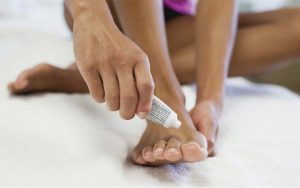Nail fungus can be unsightly indeed, but there are cases where it goes unnoticed, especially if it develops on one’s toenail. Medically termed as onychomycosis or tinea unguium, it is known to also affect the fingernail.
How to tell if you have nail fungus
Look out for a white or yellow spot under your nail, for that’s how it usually begins. If left untreated, it can cause nail damage due to infections. By identifying the signs and symptoms, you can start treating it early and prevent it from getting worse.
Diagnosis of tinea unguium
If you suspect you have nail fungus, visit your doctor for a diagnosis. Clippings from your nail may be needed for lab testing; this is to identify the type of fungus that is growing on your nail. Tests are also needed to rule out psoriasis, for instance, which can mimic a fungal infection of the nail. Microorganisms such as yeast and bacteria also can infect nails. Knowing the cause of your infection will help your doctor determine the best course of treatment.

What causes nail fungus infections?
Microscopic organisms called fungi cause nail fungal infections; they do not require sunlight to survive so can thrive in these areas.
Most commonly, a group of fungi called dermatophytes (such as Candida) is responsible for nail fungal infections. However, some yeasts and moulds also cause these infections. Pathogens that cause nail fungus infection usually enter the skin through tiny cuts or small separations between the nail and nail bed. The fungi grow when the nail provides a suitably warm and moist environment.
Treatment via medication
Your doctor may prescribe antifungal drugs that you take orally or apply to the nail, or, you may need to take both for better results.
Oral antifungal drugs: These include terbinafine (Lamisil) and itraconazole (Sporanox), which help clear the infection quickly. They also help a new nail grow free of infection. It may take up to four months for a nail infection to completely heal, depending on its severity, your age, etc.
Note: Doctors may not recommend them for people with liver disease or congestive heart failure or those taking certain medications.
Medicated nail polish: You may be prescribed an antifungal nail polish called ciclopirox (Penlac) to apply over your nails and surrounding skin once a day. Once a week, you’ll have wipe the piled-on layers clean with alcohol and begin fresh applications. This method may take longer than oral medication.
Medicated nail cream: An antifungal cream which you can rub into your infected nails after soaking them.

Other ways to treat it
You can also try over-the-counter antifungal nail creams and ointments; ask the pharmacist for a recommendation. For best results, use as indicated or as adviced by the pharmacist.
Trim and thin the nails. This helps reduce pain by reducing pressure on the nails. Also, if you do this before applying an antifungal, the drug can reach deeper layers of the nail.
Nail fungus risk factors
- Age: a factor that influences blood flow and slow nail growth
- Gender: especially men with a family history of nail fungus infections
- Location or occupation: especially if you work in a humid or moist environment or if your hands or feet are often wet
- Level of perspiration: if you’re often sweaty, especially on the hands and feet
- Clothing choices: clothing that offer poor ventilation or does not absorb perspiration
- Proximity to people with nail fungus: because you can easily be infected too
- Others; Having diabetes, circulation problems, or a weakened immune system
What are the symptoms of nail fungus infections?
Nails that are infected with fungus typically are:
- thickened
- brittle
- crumbly
- ragged
- distorted
- dull
- darker or yellowish in colour
There may be also be:
- scaling under the nail – hyperkeratosis
- yellow or white streaking – lateral onychomycosis
- yellow spots at the bottom of the nail – proximal onychomycosis
- infected nails may separate from the nail bed – onycholysis
Nail fungal infections can result in pain in the toes or fingertips, and they may even emit a foul odour. Another symptom associated with nail fungus infections are fungus-free skin lesions called dermatophytids. These may appear like rashes or itchiness in an area of the body that is not infected with the fungus – much like an allergic reaction.


